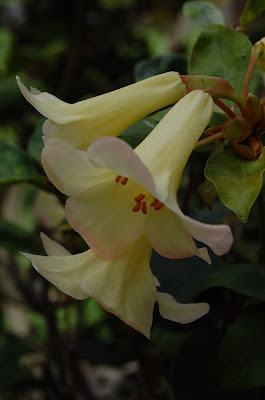Our 4 days in Dublin contained indeed more than museums, vikings (mum and dad went on a walking-tour...), parks and touristactivities. Well, maybe what I will tell you about in this chapter can by some be seen as touristy, but it was neither stressfull. filled with tourists or very noisy.
But let me tell you a little bit about James. James is a friend of mine who was going to meet us in Dublin at noon, sunday the 19th. What I did not know, was that he was already on the spot, in the same hostel as us the evening before. So going down for breakfast the 19th, half asleep, I could never have guessed what was going to happen. Make myself a big cup of tea, some toast with marmelade and start to talk to another guest at the hostel. He seemed familiar, but of course it could not be James...He would not arrive until 12 o'clock I told myself. So we chatted for a while, and it took me such a long time to realise that..."this is the man, this is James!" That was indeed a most brilliant surprise.
 |
| James; the cheeky little devil |
We had really beautiful weather, and we decided to go to the Botanical Garden and Glasnevin before we would meet James at Howth later. So off we went, with a delayed bus (was not the last one...) to what must be the biggest botanical garden I have ever seen. So many beautiful flowers and trees; a treasuretrove for a photographer with a love for details.
 |
| This architectural approach can also be seen in Belfast. Perfect for a greenhouse, wouldn't you say? |
 |
| Love this tree |
 |
| Cactus; the perfect plant for a student |
 |
| Feels like I'm in a movie from the 1890's... |
 |
| Beauty of nature |
 |
| It was hot outside...just imagine how it felt like, going through a small rainforest... |
 |
| I could sit underneath this tree all day...but alas, I did not have the time |
|
As you can see, there were a lot to take pictures of. The garden was HUGE, and I think I got lost about 2 or 4 times. In the middle of the park, there was a small pond where there were ducks. One of them also had ducklings (7 in total) and it was an amazing experience to get so close that I could take pictures of them too. The best picture of the duckling got taken by my sister, Solveig, and it shows the little duckling running across the leaves of a waterlily.
 |
| The world's most beautiful little duckling (taken by Solveig Langhelle) |
Both dad and mum enjoyed the garden, and my sister ran around on the lookout for...a scots pine (she was pretty obsessed with "The Lumberjack Song" by Monty Python). After much looking and even more walking, we found our way to the main gate.
Next stop Glasnevin; the biggest cementary in Ireland and also the last restingplace for several important figures in Irish history.
Once again I will try to keep still and let my pictures speak for themselves...
 |
| Beside the grave of Daniel O'Connell; the father of Catholic Emancipation |
 |
| A familiar figure in the graveyard; Mary |
 |
| The Angels are watching over the dead |
 |
| One of the many beautiful gravestones |
While gravestones back home in Bergen are small and almost insignificant, the Irish ones are elaborate and even artpieces. Some uses a fortune in making sure that their loved ones gets the most beautiful last restingplace.
 |
| Roger Casement's grave |
|
Roger Casement was one of those involved in the Easter Rising. He had been negotiating with the germans about buying guns for the rebels back home in Ireland. But when he landed on Banna Strand in Kerry the 21st april, 1916, he got arrested and charged with treason, sabotage and espionage.
He was hung in Pentoville Prison on the 3rd August, 1916.
Before his execution though, many pleaded for his life, among them Sir Arthur Conan Doyle and Bernard Shaw. To break the support Casement had, someone circulated a couple of pictures which supposedly showed pages from his diary. These "pages" were "proof" that Casement was a homosexual, which in these days were a crime in itself. You can imagine how this must have been seen in 1916...
 |
| A wall of commemoration |
Across the road of Glasnevin I found a memorial for the six great Irish rebellions; 1798, 1803, , 1848, 1867, 1882 and 1916. It was special to read the words intagliated in the stone, and think about those who fought and died.
 |
| These are the words from Yeats famous poem "1916". what could better suite such a place? |
I will stop now, and leave my recollection of Howth and the last day in Dublin for the next chapter.
Bye....




















1 comment:
Sounds like a great first few days here, I really liked the photos :) I've never been to either of those parts of Dublin before. And an interesting story about how they tried to smear the name of Roger Casement, I didn't know that part of his story before.
Post a Comment